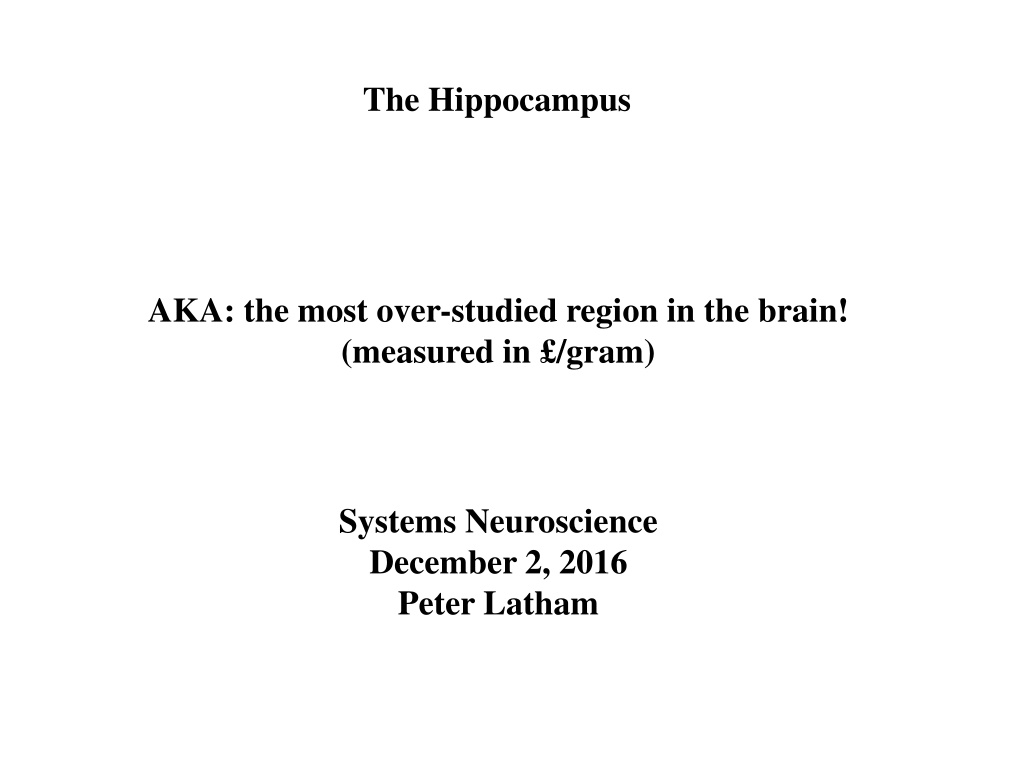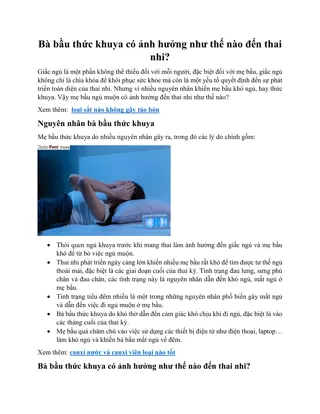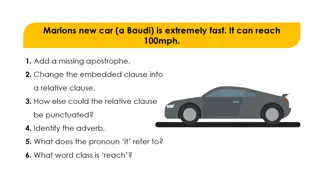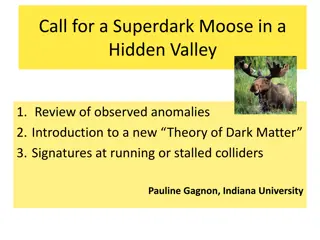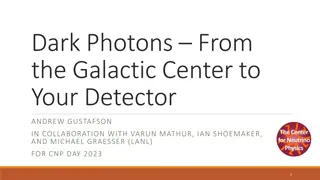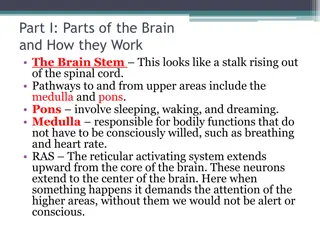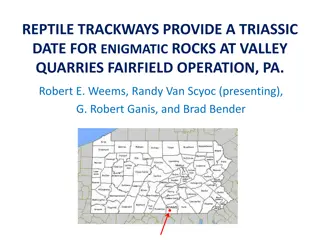Unveiling the Enigmatic Hippocampus
The hippocampus, known as the most extensively researched brain region, plays a crucial role in memory formation and transfer. Explore its functions, historical significance through HM's case, and the complex dynamics of memory storage. Delve into the challenges faced by theorists in understanding the intricate workings of this vital brain area.
Download Presentation

Please find below an Image/Link to download the presentation.
The content on the website is provided AS IS for your information and personal use only. It may not be sold, licensed, or shared on other websites without obtaining consent from the author. Download presentation by click this link. If you encounter any issues during the download, it is possible that the publisher has removed the file from their server.
E N D
Presentation Transcript
The Hippocampus AKA: the most over-studied region in the brain! (measured in /gram) Systems Neuroscience December 2, 2016 Peter Latham
Outline 1. What does the hippocampus actually do? 2. How do we figure out how it does it? a. The normative approaches. b. The modelling approach. 3. Network dynamics (whiteboard).
In the early days, the hippocampus was heavily implicated in memory formation and transfer. That s because of HM (Henry Molaison): He developed intractable epilepsy at age 13. At 27 (in 1953), surgeons removed his bilateral medial temporal lobe, including the hippocampal formation, amygdaloid complex and entorhinal cortex. The good news: his epilepsy was cured. The bad news: he couldn t form new episodic memories. He could learn things like tennis or piano (procedural memory), but he had no explicit memory of learning them. He had retrograde amnesia: he could not remember most events in the one- to two-year period before surgery, nor some events up to 11 years before, meaning that his amnesia was temporally graded. - - - - - -
In the early days, the hippocampus was heavily implicated in memory formation and transfer. That s because of HM (Henry Molaison): He developed intractable epilepsy at age 13. At 27 (in 1953), surgeons removed his bilateral medial temporal lobe, including the hippocampal formation, amygdaloid complex and entorhinal cortex. The good news: his epilepsy was cured. The bad news: he couldn t form new episodic memories. He could learn things like tennis or piano (procedural memory), but he had no explicit memory of learning them. He had retrograde amnesia: he could not remember most events in the one- to two-year period before surgery, nor some events up to 11 years before, meaning that his amnesia was temporally graded. - - - - - -
Conclusion: the hippocampus is a scratch pad; it remembers things quickly, and slowly transfers them to your cortex, where they remain for decades. That s a sensible system: you form episodic memories immediately, which means you have to learn fast. however, fast learning means old memories are quickly overwritten. the hippocampus learns quickly but doesn t store things for long; the cortex learns slowly (presumably from the hippocampus), but stores things for a very long time. - - - But quickly and slowly are relative: HM could not remember most events in the one- to two-year period before surgery, nor some events up to 11 years before.
Theorists worked half-heartedly on this problem, but not much progress was made (except perhaps by Stefano Fusi, but the jury is still out). That s because we have absolutely zero good models for memory storage. In 1971, John O Keefe discovered (as usual, quite by accident) place cells in hippocampus. Now theorists had something they could sink their teeth into, and they spent a lot of time modeling place cells. But, as is usually, the case, things are more complicated than they seem at first: the hippocampus is not just about place.
Place cells remap. context A context B place fields
Cells in hippocampus code for more than just place. context A context A position 1 Y- X+ + is rewarded at both positions. position 2 X+ Y- Contexts A and B: different flooring and visual cues. context B context B Y+ X- X- Y+ Komorowski, Mann and Eichenbaum, J. Neurosci. 29:9918-9929 (2009)
context A context B position 1 activity in hippocampus is telling you about the structure of the environment. position 2
Finally, in 2004 grid cells appeared. These are cells that fire in lots of different places.
place cell grid cell sensible representation of space crazy representation of space
Finally, in 2004 grid cells appeared. These are cells that fire in lots of different places. Why grid cells are a crazy idea for representing space: - if a single place cell fires you know more or less where you are - if a single grid cell fires you have no idea But it s more efficient. (As we ll see.) But it s way too efficient! (As we ll see.) Grid cells remain a mystery, in my humble opinion.
Given all this data, what are we going to do? Three main options: 1. Take the normative approach: guess a function for the hippocampus; ask how it should be carrying out that function; perform experiments to confirm or rule out your theory. Explain phenomena that is observed in the hippocampus. Work on something else. 2. 3. my personal favorite
The normative approach first (its more fun). What problem is the hippocampus solving? It s not figuring out where you are. - - - Place cells don t tell you where you are. Figuring out where you are relative to local landmarks is easy. Figuring out context which determines what actions are available to you is hard.
The normative approach first (its more fun). What problem is the hippocampus solving? My guess: the hippocampus is inferring context. That is a really hard problem: P(context|sensory data) P(sensory data|context) P(context) a very complicated distribution. context: sensory data: sitting in a lecture depends on which lecture, who s talking, what you re looking at,
The normative approach first (its more fun). What problem is the hippocampus solving? My guess: the hippocampus is inferring context. Hippocampus is ideally suited to this task, in the sense that it gets input form all areas of the brain. As far as I know, however, there has been essentially no work done on this. It s sort of easy to see why: it s really, really hard.
The normative approach first (its more fun). What problem is the hippocampus solving? My guess: the hippocampus is inferring context. Hippocampus is probably also involved in memory transfer to cortex (remember the retrograde amnesia of HM). This is an easier problem, but progress has still been slow.
Probably because a normative approach to the hippocampus is so hard, people have mainly focused on explaining phenomena: build a network model of place fields build a network model of grid cells - - People have also asked a very sensible question: why grid cells? So far they haven t answered it. In my humble opinion. First, though, some background on network dynamics. Which will involve a mild detour on the whiteboard.
